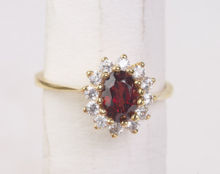Ruby
From Giftypedia
Known as King of the Gems and considered one of the four precious stones, along with the emerald, diamond and sapphire, the ruby is one of the most expensive and sought after gems in the world. Despite the high price tag, rubies are considered a must-have for many women. Ruby jewelry ensembles consisting of earrings, a necklace and a ring are a desired addition to a jewelry wardrobe. Rubies are often pared with pearls and diamonds to create exquisite jewelry. Their red aura makes them appear larger than they really are.
The color of the ruby is the most important factor in determining the price. The brightest red is called "pigeon blood red" and brings a much higher premium over other rubies of similar quality. After color follows clarity, then cut and carat in determining value.
Rubies are members of the corundum family of minerals. Corundum in any other color are called "sapphires." The natural red color varies from light to dark and can have undertones of purple. These variations add to the character of the ruby. Unlike diamonds, a flawless ruby does not exist.
[edit] Recommended Gifting Occasions and Holidays for the Ruby
- Engagement - Because of its fiery red color, the ruby is associated with romance, devotion, love and passion. For this reason, the ruby has become a popular choice for engagement rings. Prince Andrew gave Fergie, the Duchess of York, a ruby engagement ring.
- Anniversary - Represented in the Anniversary Table for the 40th year, the ruby is also a good choice for any anniversary year.
- Dating Anniversary - The gift of a ruby confirms your devotion to your sweetheart.
- Renewal of Vows - A diamond the first time? The gift of a ruby is a wonderful way to say that you would do it all over again!
- Valentine’s Day - Red for Valentine’s Day! No wonder the ruby is a popular choice with its association to love and romance.
[edit] Superstitions
Those who wear Rubies are believed blessed with wealth and fertility and protected from pain and sorrow. Legend has it that ancient warriors implanted rubies under their skin to give them courage before entering into battle. However, only genuine rubies contained these powers and if the gemstones were fake, they would bring bad fortune. Imitations have been traced as far back as Roman times.
Rubies have been used for centuries for healing. Ancient cultures believed the ruby could cure ailments of the digestive system, of the heart and the blood.
In England, rubies as gifts were popular among royalty. Rubies were also used for coronation.
Even today, it is considered lucky to wear ruby jewelry on Tuesdays.
[edit] Before You Buy
| Facts | Cuts & Varieties | Buyer Tips |
|---|---|---|
|
|
|
[edit] Buyer Beware
There are many enhancement practices that are commonly used by the jewelry industry to improve the gems look. Common enhancements include exposing the ruby to heat to melt way imperfections and improve the stone's color and clarity. Other practices include bleaching, irradiation and filling the gem with oil, wax or resin. These practices are considered routine as untreated rubies with no to minimal flaws are highly expensive.
On the other hand, you'll want to avoid rubies that have been treated by filling in the cracks with tinted lead glass. This practice is invisible to the naked eye, but weakens the stone and can easily lead to breakage. Filling a ruby with a glass filler forever alters the stone making it impossible to repair. Unfortunately, this is a serious problem in today's industry.
Before you buy, be sure to ask the following questions. Federal law requires a full refund if the product was misrepresented when sold.[1]
- Was the ruby treated?
- How was it treated?
- Is there lead glass in the ruby?
[edit] References
- ↑ Secrets of the Jewelry Industry: What Your Jeweler Won’t Tell You by Morgan Korn | Daily Ticker, February 8th, 2013 on Yahoo! Finance




 Printer Friendly
Printer Friendly
